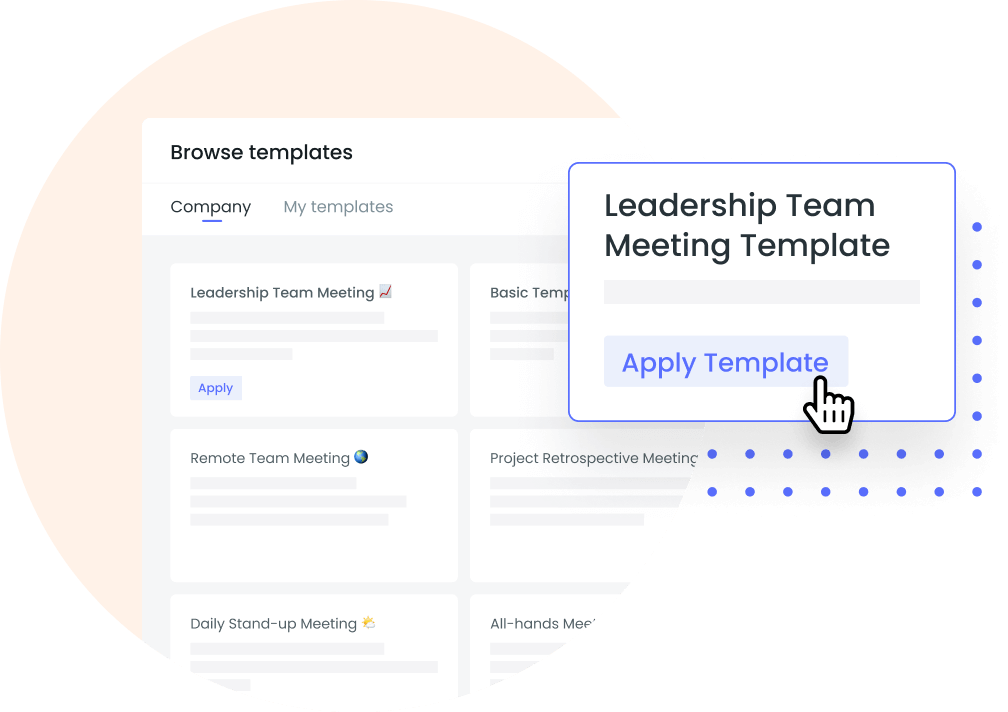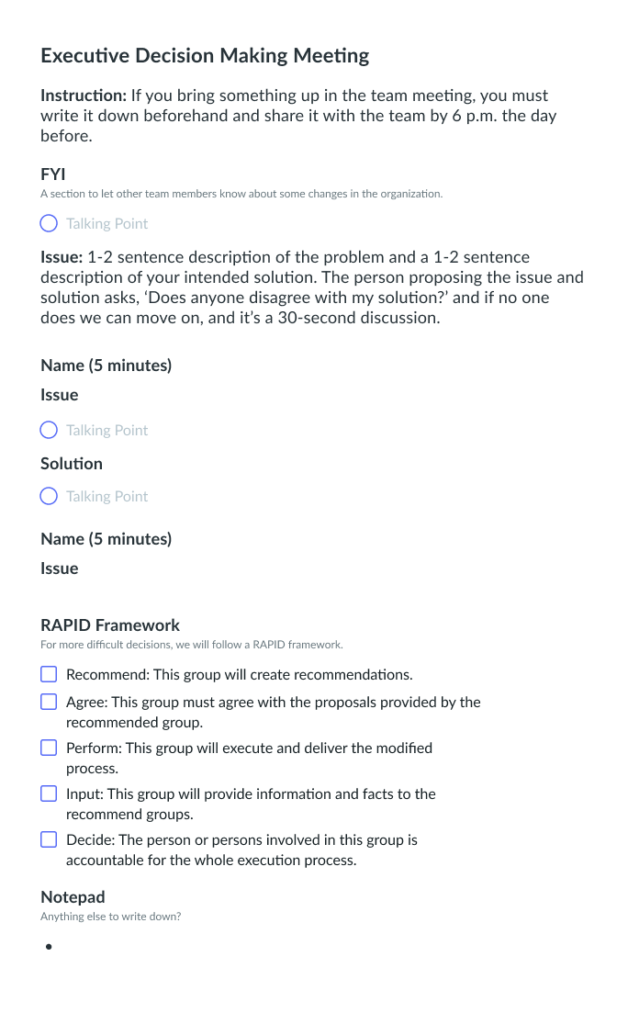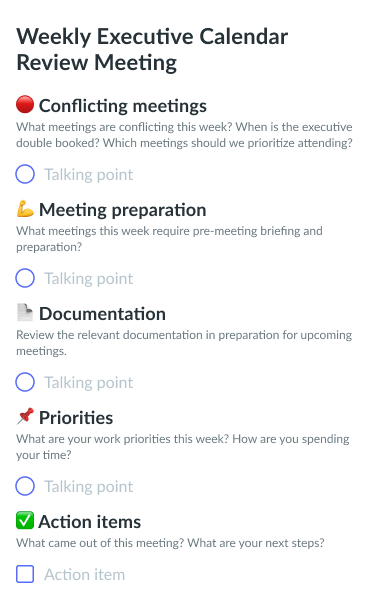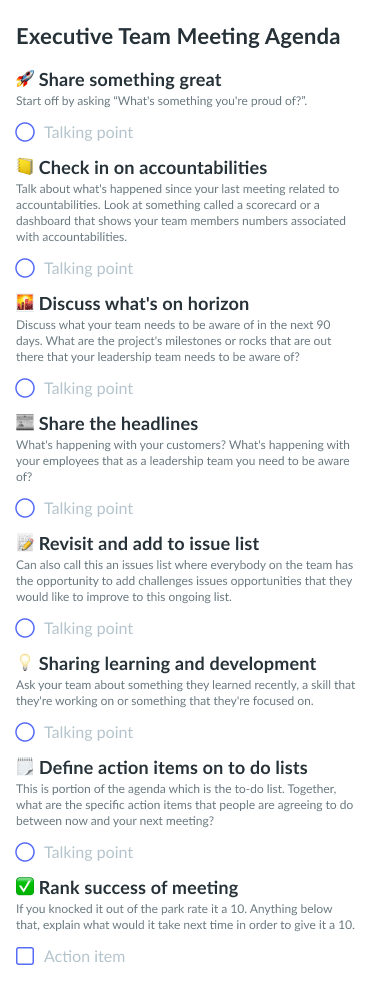Best Practices for Managing Meetings for an Executive (+ Free Templates)
Learn who manages executive meetings and 10 best practices for managing meetings for an executive. Plus, gain access to exclusive templates!
Do you have a meeting coming up that you’re eager to host? Maybe you’re an executive preparing for a meeting with other executives within your organization? Or, maybe you work in admin and you’re in charge of facilitating the meeting for your superiors? No matter your role, the fundamentals are the same. In this article, we’ll dive into tips, tricks, and best practices for facilitating meetings for busy executives. You’ll also gain access to exclusive meeting agenda templates that will help you structure your meeting efficiently and professionally.
- Who manages executive meetings?
- Why is it important to effectively manage meetings for an executive?
- 10 best practices for managing meetings for an executive
Who manages executive meetings?
There are a variety of people who may be responsible for facilitating meetings for executives, including executive assistants, the chief of staff, or even the executive themselves. What’s important to remember is that the roles and responsibilities don’t change no matter who’s responsible. Whether you’re an admin in charge of facilitating or an executive ready to take the reins, these tips, tricks, and best practices will ensure you have everything you need to manage your next meeting.

Meetings worth showing up to
A well-run meeting can foster communication and collaboration by including an agenda the whole team can contribute to. Try using a tool like Fellow!

Why is it important to effectively manage meetings for an executive?
Learning how to manage meetings for an executive is an extremely important skill set. If you’re responsible for facilitating exec meetings, you’ll want to ensure you’re organized and have everything you need to make sure the meeting runs smoothly from start to end. These meetings offer a unique opportunity to gather all key stakeholders and executives in one space which is why it’s extremely important to cross your t’s and dot your i’s.
10 best practices for managing meetings for an executive
- Prepare a meeting agenda
- Share the meeting agenda 24 hours before the meeting
- Use meeting agenda templates
- Assign meeting roles
- Make sure there’s a purpose to the meeting
- Consider time zones
- Send meeting reminders and confirmations
- Send attendees the documents to be discussed in the meeting
- Take meeting minutes
- Write a meeting follow-up email
1Prepare a meeting agenda
We’ve said it before and we’ll say it again: no agenda, no attenda! There’s nothing worse than attending a meeting with no agenda, especially when you’re facilitating a meeting for busy executives. Failing to create a meticulous agenda consisting of all the key talking points and action items will result in a chaotic meeting and may even lead to important action items being forgotten. Tools like Fellow make creating a thorough, collaborative meeting agenda easier than ever. Not only does Fellow provide you with templates and guidance, but it also allows you to share your agenda before the meeting and have guests weigh in on their areas of expertise.
2Share the meeting agenda 24 hours before the meeting
Executives are extremely busy, so as the meeting facilitator, it’s important that you circulate an agenda consisting of meeting roles, action items, and talking points. Sharing the meeting agenda at least 24 hours before the meeting will allow everyone who’s expected to attend to prepare and familiarize themselves with the meeting content. Sharing the meeting agenda ahead of time also means the attendees will know what to expect and can plan their participation accordingly.
3Use meeting agenda templates
If you’re new to facilitating meetings, or even if you’re simply looking to up your game, meeting agenda templates are a great tool you can leverage to stay organized and on track and to ensure you don’t forget any key information. Wary of starting from scratch? Fellow has created a thorough meeting agenda template gallery full of stellar meeting agenda templates, including templates for one-on-ones and project kick-off meetings.
Learning how to manage meetings for an executive can seem daunting, but luckily there are numerous free resources—like free meeting agenda templates—that make the process easier for first-timers.

4Assign meeting roles
Every great meeting has a meeting host, a notetaker, and a timekeeper. These meeting roles are essential, and as the facilitator, it’s your responsibility to make sure you assign these roles before the meeting start date. Having a notetaker, a timekeeper, and a meeting host will help the meeting run smoothly from start to finish. Assigning these roles will also ensure the meeting is prompt and doesn’t go over time, and that all key talking points are accounted for. With a notetaker present, you’ll know that everything is documented for future reference, so if anyone in attendance needs to reference an important point at a later date everything will be accounted for in your meeting notes.
5Make sure there’s a purpose to the meeting (if not, cancel the meeting!)
Canceling unnecessary meetings is often taboo, but there’s no reason for it to be. Oftentimes employees—and especially executives—have back-to-back meetings. These busy calendars can make it extremely difficult to find time for deep work or collaboration, which is why it’s more important than ever to cancel any unnecessary meetings. If the topic to be discussed can be an email, send an email! If you can cover it asynchronously via Slack, send a Slack message! If you’re facilitating a meeting just to have a meeting, cancel it. Taking up people’s valuable time with an unnecessary meeting isn’t doing anyone any favors, especially when this time could be better used elsewhere.
6Consider time zones
Just because you’re meeting via video chat doesn’t mean that everyone has the same availability. An important scheduling consideration to keep in mind is that not everyone may be operating within the same time zones. To avoid any scheduling issues, you can simply check everyone’s availability before booking a time slot. Alternatively, you can take everyone’s time zones into consideration and choose a neutral time that’s safe for everyone. If you aren’t sure where to start, simply reach out and gauge when everyone may or may not be available.
7Send meeting reminders and confirmations
There’s nothing worse than gearing up for a big meeting only to have key stakeholders forget or not attend. These meetings are happening for a reason, and nine times out of 10 if someone is on the guest list, it’s because their opinion is valued and they need to be there. Sending meeting reminders and confirmations will ensure that everyone who’s supposed to attend remembers to do so. If you realize that the majority of the guest list isn’t able to attend, you’ll be able to pivot and reschedule the meeting.
8Send attendees the documents to be discussed in the meeting
Similar to the way in which you would circulate the meeting agenda before the meeting, circulating any and all documents that pertain to the meeting before the meeting is equally as important. Sending these documents ahead of the meeting will ensure everyone has the opportunity to familiarize themselves with the content beforehand. Everyone being on the same page means the meeting will run more effectively and will move quickly and efficiently from one action item to the next, especially if the host or facilitator doesn’t have to spend extra time explaining a topic or providing context.
9Take meeting minutes
This is where your notetaker comes in! Meeting minutes are imperative when it comes to referencing key decisions in the future—including, but not limited to, votes taken, conflicts that may have arisen, and other important details. Thorough meeting minutes can also help provide structure and ensure accountability when it comes to following up on future deadlines or projects.
10Write a meeting follow-up email
Meeting follow-up emails are a great way to make sure everyone is on the same page after the meeting and has all the key information. The best part about sending these emails post meeting is that you’re able to loop everybody in, whether or not they were able to attend the meeting. This email is also a great opportunity to send any notes or meeting minutes to the entire group. If you’ve ended the meeting with action items, this is the ideal time to follow up and ensure everyone’s on the right track.
Free meeting agenda templates for executives



How to manage meetings for an executive
When learning how to manage meetings for an executive, remember that hosting exec meetings is just like hosting any other meeting. The stakes may be higher, but the fundamentals are the same. You have to create a thorough meeting agenda, invite the proper stakeholders, assign key meeting roles, and make sure any and all information is made accessible before the meeting, during the meeting, and after the meeting. It’s as easy as that!










